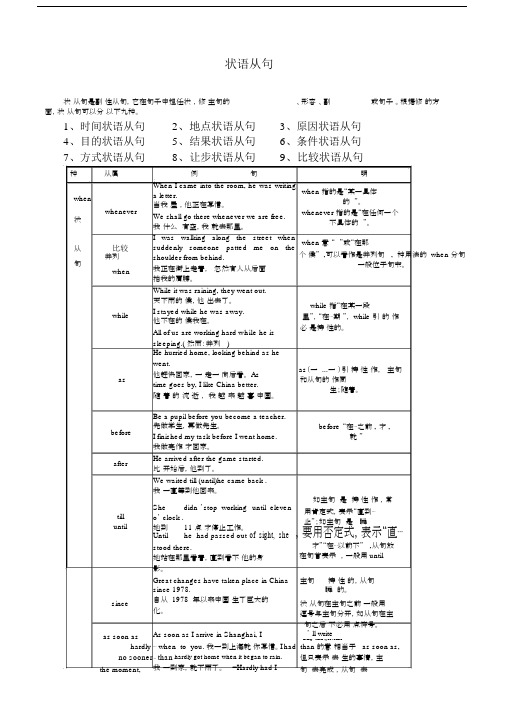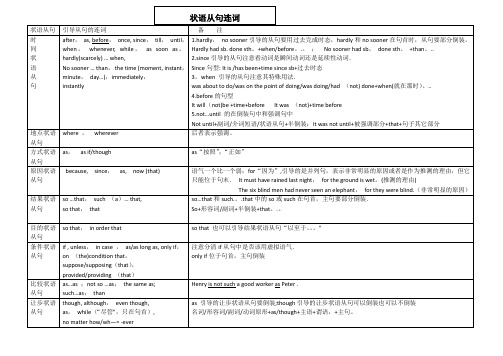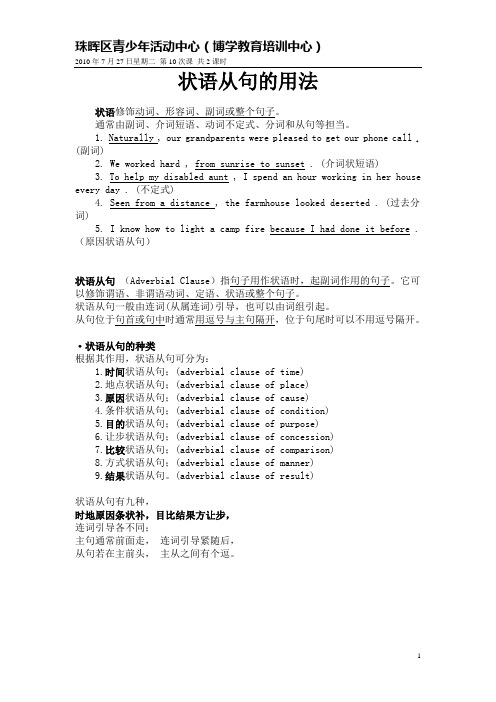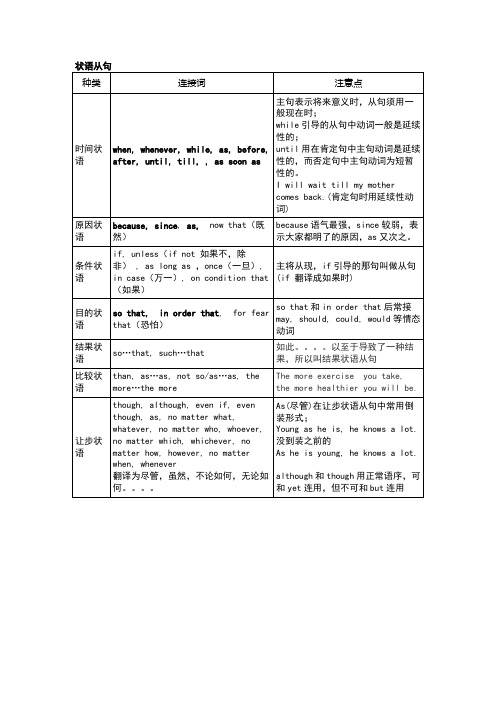状语从句表格整理
状语从句表格

As(尽管)在让步状语从句中常用倒装形式;
Young as he is,he knows a lot。
没到装之前的
As he is young,he knows a lot.
although和though用正常语序,可和yet连用,但不可和but连用
状语从句
种类
连接词
注意点
时间状语
when,whenever,while,as,before,after, until,till,, as soon as
主句表示将来意义时,从句须用一般现在时;
while引导的从句中动词一般是延续性的;
until用在肯定句中主句动词是延续性的,而否定句中主句动词为短暂性的。
比较状语
than, as…as, not so/as…as, the more…the more
The more exercise you take, the more healthier you will be。
让步状语
though, although,even if,even though, as,no matter what, whatever,no matterwho,whoever,no matter which,whichever,no matter how,however,no matter when,whenever
以至于导致了一种结果所以叫结果状语从句比较状morethemoremoreexerciseyoutakemorehealthieryouthoughalthougheveneventhoughmatterwhatwhatevermatterwhowhoevermatterwhichwhichevermatterhowhowevermatterwhenwhenever翻译为尽管虽然不论如何无论如as尽管在让步状语从句中常用倒装形式
状语从句(高中语法)

状语从句一、状语从句概述状语从句是在句中起副词作用的主谓结构。
用来修饰主句中的动词、形容词、副词等。
引导状语从句的关联词是从属连词。
状语从句用陈述语序,一般位于复合句的句首或句末。
当从句在句首时,常用逗号和主句隔开。
状语从句根据其在句中的不同作用分别表示时间、地点、原因、目的、结果、条件、让步、行为方式等,共九种。
(一)when, whenever, while和as引导的时间状语从句when表示的动作与主句的动作同时发生,或先于主句的动作。
When可指一段时间,也可指一点时间,既可以表示一时性的动作,又可表示持续的动作。
Whenever指的是任何一个不具体的时间。
while常用来引导两个同时进行的持续时间较长的动作或状态,不能表示一时性或短暂的动作。
as表示的动作与主句同时发生,具有延续的含义,一般同延续性动词连用。
while和as可译为“一边……一边”。
Whenever my mother or I need a permanent or trim we visited her dear Amalia Toland.As the day progressed, I considered ways to get out of whatever was going down at the Cullen House tonight.Whenever we met with difficulties, they came to help us.When I meet the right man, I will get married.As spring warms the good earth, all flowers begin to bloom.He entered the room when/ while/ as the meeting was going on.When/As he finished the speech, the audience burst into applause.Tom watched TV as he had supper.注意:When和while可用作并列连词,when含义为“突然、这时”;while含义为“而,但是”。
高三英语状语从句表格

till
until
We waited till (until)he came back .
我们一直等到他回来。
She didn’t stop working until eleven o’clock .
她到11点钟才停止工作。
Until he had passed out of sight, she stood there.
我一听到这首歌,就感到很愉快
hardly…when和no sooner…than的意义相当于as soon as,但只表示过去发生的事情,主句为过去完成时,从句为过去时,如hardly或no sooner位于句首时语气强,而且主句的谓语要用部分倒装。
every time,
each time
last time
No sooner had we got to the station than the train left.
我们刚到车站,火车就走了。
Hardly had we begun when we were told to stop.
我们刚开始就被叫停。
The moment I heard the song, I felt cheerful.
自从1978年以来中国发生了巨大的变化。
主句动词应为持续性的,从句动词为瞬间的。
状语从句在主句之前时一般用逗号与主句分开,如从句在主句之后则不必用标点符号。
as soon as
hardly…when
no sooner…than
the moment,
the instant,
the second,
immediately,
你可以随意到你喜欢的任何地方去。
状语从句连词表格

状语从句 时 间 状 语 从 句
地点状语 从句 方式状语 从句 原因状语 从句
结果状语 从句
引导从句的连词
备注
after, as, before, once, since, till, until, 1.hardly, no sooner 引导的从句要用过去完成时态,hardly 和 no sooner 在句首时,从句要部分倒装.
so that 也可以引导结果状语从句“以至于。。。" 注意分清 if 从句中是否该用虚拟语气. only if 位于句首,主句倒装
Henry is not such a good worker as Peter . as 引导的让步状语从句要倒装;though 引导的让步状语从句可以倒装也可以不倒装 名词/形容词/副词/动词原形+as/though+主语+谓语,+主句。
when, whenever, while, as soon as, hardly Hardly had sb。 done sth.+when/before... ; No sooner had sb。 done sth. +than..。
(scarcely) … when,
2.since 引导的从句注意看动词是瞬间动词还是延续性动词.
比较状语 从句 让步状语 从句
so that, in order that
if , unless, in case , as/as long as, only if, on (the)condition that, suppose/supposing(that), provided/providing (that) as…as ;not so …as; the same as; such…as; than though, although, even though, as, while(“尽管”,只在句首),
状语从句表--实用格.doc

状语从句状从句是副性从句,它在句子中担任状,修主句的、形容、副或句子。
根据修的方面,状从句可以分以下九种。
1、时间状语从句4、目的状语从句7、方式状语从句种从属2、地点状语从句3、原因状语从句5、结果状语从句6、条件状语从句8、让步状语从句9、比较状语从句例句明whenwhenever 状从比较并列句when When I came into the room, he was writinga letter.当我屋,他正在写信。
We shall go there whenever we are free.我什么有空,我就去那里。
I was walking along the street whensuddenly someone patted me on theshoulder from behind.我正在街上走着,忽然有人从后面拍我的肩膀。
when 指的是“某一具体的”。
whenever 指的是“在任何一个不具体的”。
when 意“ ”或“在那个候” ,可以看作是并列句 , 种用法的 when 分句一般位于句末。
while as before While it was raining, they went out.天下雨的候,他出去了。
I stayed while he was away.他不在的候我在。
All of us are working hard while he issleeping.( 然而:并列 )He hurried home, looking behind as hewent.他赶快回家,一走一向后看。
Astime goes by, I like China better.随着的流逝,我越来越喜中国。
Be a pupil before you become a teacher.先做学生,再做先生。
I finished my task before I went home.我做完作才回家。
状语从句连词表格

so that 也可以引导结果状语从句“以至于。。。" 注意分清 if 从句中是否该用虚拟语气. only if 位于句首,主句倒装
Henry is not such a good worker as Peter . as 引导的让步状语从句要倒装;though 引导的让步状语从句可以倒装也可以不倒装 名词/形容词/副词/动词原形+as/though+主语+谓语,+主句。
No sooner … than, the time (moment, instant, Since 句型: It is /has been+time since sb+过去时态
minute, day…),immediately,
3。when 引导的从句注意其特殊用法.
instantly
was about to do/was on the point of doing/was doing/had (not) done+when(就在那时)。..
比较状语 从句 让步状语 从句
so that, in order that
if , unless, in case , as/as long as, only if, on (the)condition that, suppose/supposing(that), provided/providing (that) as…as ;not so …as; the same as; such…as; than though, although, even though, as, while(“尽管",只在句首), no matter how/wh—= -ever
4.before 的句型
状语从句表格

Wherever you go, you must obey the law.
无论你去哪都要遵守法律。
where与wherever意义基本相同,但后者语气较强,多用于书面语。
原
因
状
语
从
句
because
I came back late yesterday because I was on duty.
directly,
instantly
As soon as I arrive in Shanghai, I’ll write to you.我一到上海就给你写信。I had hardly got home when it began to rain.
我刚一到家,就下雨了。=Hardly had I got home when it began to rain.
自从1978年以来中国发生了巨大的变化。
主句动词应为持续性的,从句动词为瞬间的。
状语从句在主句之前时一般用逗号与主句分开,如从句在主句之后则不必用标点符号。
as soon as
hardly…when
no sooner…than
the moment,
the instant,
the second,
immediately,
whenever指的是“在任何一个不具体的时间”。
比较
并列连词
when
I was walking along the street when suddenly someone patted me on the shoulder from behind.
我正在街上走着,这时忽然有人从后面拍我的肩膀。
when意为“这时”或“在那个时候”,可以看作是并列句,这种用法的when分句一般位于句末。
状语从句连词表格

Hardly had sb. done sth.+when/before... ; No sooner had sb. done sth. +than...
when, whenever, while, as soon as, 2.since 引导的从句注意看动词是瞬间动词还是延续性动词.
hardly(scarcely) … when,
so that 也可以引导结果状语从句“以至于...” 注意分清 if 从句中是否该用虚拟语气. only if 位于句首,主句倒装
Henry is not such a good worker as Peter .
;..
.
让步状语 though, although, even though,
as 引导的让步状语从句要倒装;though 引导的让步状语从句可以倒装也可以不倒装
Since 句型: It is /has been+time since sb+过去时态
3.when 引导的从句注意其特殊用法.
No sooner … than, the time (moment, instant, was about to do/was on the point of doing/was doing/had (not) done+when(就在那时)...
The six blind men had never seen an elephant, for they were blind.(非常明显的原因) so…that 和 such...that 中的 so 或 such 在句首,主句要部分倒装. So+形容词/副词+半倒装+that...
目的状语 从句
新概念英语语法:状语从句表格

状语从句指句子用作状语时,起副词作用的句子。
它可以修饰谓语、非谓语动词、定语、状语或整个句子。
根据其作用可分为时间、地点、原因、条件、目的、结果、让步、方式和比较等从句。
状语从句一般由连词(从属连词)引导,也可以由词组引起。
种类从属连词例句说明时间状语从句whenwheneverWhen I came into the room, he was writing a letter.当我进屋时,他正在写信。
We shall go there whenever we are free.我们什么时间有空,我们就去那里。
when指的是“某一具体的时间”。
whenever指的是“在任何一个不具体的时间”。
whenI went to Beijing when I was five years old.It was foolish of you to take a taxi when you couldeasily walk there in five minutes.I was walking along the street when suddenlysomeone patted me on the shoulder from behind.I had just gone to bed when the telephone rang.We were about to start when it began to rain.We were on the point of giving up when a truck cameinto our sight.当…时候when引导的从句动词短暂性,延续性皆可。
when可表示原因,既然,相当于sincewhen可意为“这时”或“在那个时候”,表突然含义,可以看作是并列句,这种用法的when分句一般位于句末。
when的常见句型:was/were doing …when;正在做某事的时候突然had done … when;刚做完某事时突然be about to do…when;正要做某事时突然be on the point of doing…when;正要做某事时突然while While it was raining, they went out.天下雨的时候,他们出去了。
状语从句表格

when意为“这时”或“在那个时候”,可以看作是并列句,这种用法的when分句一般位于句末。
while
While it was raining, they went out.
天下雨的时候,他们出去了。
I stayed while he was away.
万一我忘了,请提醒我一下。
So far as I know, the book will be published next month.
据我所知,那本书下月出版。
unless从句的谓语只能用肯定式。unless和if…not同义,unless是书面语,if…not是口语,通常二者可以换用。
条件状语从句中的谓语动词的时态一般要用现在时或过去时代替一般将来时或过去将来时。
= We shall go there tomorrow if it doesn’t rain.
Solong as you work hard, you will succeed.只要努力,你就会成功。
只要你努力工作,你就一定能成功。
In case I forget, please remind me about it .
在时间状语从句中,不能用将来时或过去将来时,而要用一般现在时或一般过去时代替将来时。
地
点
状
语
从
句
where
wherever
Where there is a will, there is a way.
有志者,事竟成。
Where there is water there is life.
哪里有水,哪里就有生命。
我们一直等到他回来。
She didn’t stop working until eleven o’clock .
自编状语从句的用法表格

状语从句的用法状语修饰动词、形容词、副词或整个句子。
通常由副词、介词短语、动词不定式、分词和从句等担当。
1. Naturally , our grandparents were pleased to get our phone call . (副词)2. We worked hard , from sunrise to sunset . (介词状短语)3. To help my disabled aunt , I spend an hour working in her house every day . (不定式)4. Seen from a distance , the farmhouse looked deserted . (过去分词)5. I know how to light a camp fire because I had done it before .(原因状语从句)状语从句(Adverbial Clause)指句子用作状语时,起副词作用的句子。
它可以修饰谓语、非谓语动词、定语、状语或整个句子。
状语从句一般由连词(从属连词)引导,也可以由词组引起。
从句位于句首或句中时通常用逗号与主句隔开,位于句尾时可以不用逗号隔开。
·状语从句的种类根据其作用,状语从句可分为:1.时间状语从句;(adverbial clause of time)2.地点状语从句;(adverbial clause of place)3.原因状语从句;(adverbial clause of cause)4.条件状语从句;(adverbial clause of condition)5.目的状语从句;(adverbial clause of purpose)6.让步状语从句;(adverbial clause of concession)7.比较状语从句;(adverbial clause of comparison)8.方式状语从句;(adverbial clause of manner)9.结果状语从句。
表格“话”状语从句

表格“话”状语从句状语从句是在复合句中充当状语,用来修饰谓语动词、形容词和副词的句子。
状语从句按其意义和作用可以分为时间、地点、原因、条件、结果、方式、让步状语从句等。
在高考中主要考查一下几个方面:①引导状语从句的从属连词;②主从句的时态、语态;③与其他从句和句型的区别;④从句中的省略。
考点例析1.___________ the Internet is bridging the distance between people, it may also be breaking some homes or will cause other family problems.2. The cost of living in Glasgow is among the lowest in Britain, _________ the quality of life is probably one of the highest.3. It was not until near the end of the letter ________ she mentioned her own plan.4. One Friday, we were packing to leave for a weekend away ________ my daughter heard cries for help.5. I have heard a lot of good things about you _________ I came back from abroad.6. ________ I really don‟t like art, I find his work impressive.7. You must learn to consult your feelings and your reasons _________ you reach any decision.表二地点状语从句考点例析1. A number of high buildings have arisen ________ there was nothing a year ago but ruins.2.In peace too, the Red Cross is expected to send help ___________ there is human suffering.3.Everything was placed exactly___________ he wanted it for the graduation ceremony.1.Mark needs to learn Chinese ____________ his company is opening a branch in Beijing.2.He found it increasingly difficult to read, _________ his eyesight was beginning to fail.句型转换He is so young that he can‟t join the army.= He is ________ ___________ __________ join the army.= He is ________ ___________ __________ to join the army.= He is so young __________ ___________ ___________ join the army.表五方式状语从句考点例析考点例析1.I don ‟t believe we ‟ve met before, __________ I must say you do look familiar.2. _____________ I have to give a speech, I get extremely nervous before I start.3. One can always manage to do more things, no matter _____________ full one ‟s schedule is in life.4. —— Look at those clouds!—— Don ‟t worry. __________ it rains, we …ll still have a great time.表八 比较状语从句动词。
状语从句表格

原因状语
because, since,as,now that(既然)
because语气最强,since较弱,表示大家都明了的原因,as又次之。
条件状语
if, unless(if not 如果不,除非),as long as,once(一旦), in case(万一), on condition that(如果)
翻译为尽管,虽然,不论如何,无论如何。。。。
As(尽管)在让步状语从句中常用倒装形式;
Young as he is, he knows a lot.
没到装之前的
As he is young, he knows a lot.
although和though用正常语序,可和yet连用,但不可和but连用
主将从现,if引导的那句叫做从句(if 翻译成如果时)
目的状语
so that,in order that,for fear that(恐怕)
so that和in order that后常接may, should, could, would等情态动词
结果状语
so…that, such…that
如此。。。。以至于导致了一种结果,所以叫结果状语从句
ห้องสมุดไป่ตู้比较状语
than, as…as, not so/as…as, the more…the more
The more exercise you take, the more healthier you will be.
让步状语
though, although, even if, even though, as, no matter what, whatever, no matter who, whoever, no matter which, whichever, no matter how, however, no matter when, whenever
状语从句连词表格

where , wherever as, as if/though
because, since, as, now (that)
so …that, so that,
so that 也可以引导结果状语从句“以至于。。.” 注意分清 if 从句中是否该用虚拟语气. only if 位于句首,主句倒装
Henry is not such a good worker as Peter 。 as 引导的让步状语从句要倒装;though 引导的让步状语从句可以倒装也可以不倒装 名词/形容词/副词/动词原形+as/though+主语+谓语,+主句.
状语从句连词
状语从句
时 间 状 语 从 句
地点状语 从句 方式状语 从句 原因状语 从句
结果状语 从句
引导从句的连词 after, as, before, once, since, till, until,
when, whenever, while, as soon as, hardly (scarcely) … when,
as“按照”;“正如”
语气一个比一个弱;for“因为”,引导的是并列句,表示非常明显的原因或者是作为推测的理由,但它 只能位于句末. It must have rained last night, for the ground is wet。(推测的理由)
The six blind men had never seen an elephant, for they were blind。(非常明显的原因) so…that 和 such...that 中的 so 或 such 在句首,主句要部分倒装. So+形容词/副词+半倒装+that.。。
高三英语状语从句表格

for连接的是并列句。
now that,
seeing that,
considering that,
Now (that) the weather has cleared up, we can start our journey.
鉴于天气已经晴朗,我们可以启程了。
directly,
instantly
As soon as I arrive in Shanghai, I’ll write to you.我一到上海就给你写信。I had hardly got home when it began to rain.
我刚一到家,就下雨了。=Hardly had I got home when it began to rain.
地
点
状
语
从
句
where
wherever
Where there is a will, there is a way.
有志者,事竟成。
Where there is water there is life.
哪里有水,哪里就有生命。
You are free to go wherever youwant to.
状
语
从
句
when
whenever
When I came into the room, he was writing a letter.
当我进屋时,他正在写信。
We shall go there whenever we are free.
我们什么时间有空,我们就去那里。
when指的是“某一具体的时间”。
多穿点衣服,以免患感冒。
状语从句表格

状语从句是副词性从句,它在句子中担任状语,修饰主句的动词、形容词、副词或句子。
根注意:时间状语从句(1)当主句是一般将来时、祈使句或主句中含有情态动词,这些词引导的从句要用一般现在时(主将从现)Don’t go to bed until you finish your homework.(2)When while as 的辨析A.相同点:都是“当。
时“不同点:when后用短暂性动词,指时间点,此时该从句的时态是一般现在时或一般过去时,后也可用延续性动词,指时间段,时态通常是进行时。
He was watching Tv when I came back.B.while引导的从句后必须是延续性动词,指时间段,常用进行时Someone knocked at the door while she was cooking.C.as着重指主从句同时发生“一边…一边“As we walked,we talked.(3)since 引导的从句一般用过去时,主句用现在完成时I have learnt English since I was 4 .目的状语和结果状语(1)目的状语从句引导词:so that. in order that从句中常用情态动词。
★so that既可引导目的状语从句,又可引导结果状语从句。
区别这两种从句的办法有两个:1)目的状语从句里往往带有情态动词can, could, may, mightwould等。
2)从意思上看,目的状语从句往往表示的目的很明确。
例如:Speak clearly so that they may understand you. (目的状语从句)Jack is badly ill so that he has to rest. (结果状语从句)(2)结果状语从句引导词:so...that,such...that.(3)so与such的区别①so+形+a/an+名单=such+a/an+形+名单②so+many/much/few/little+形+名(只能用so, 不用such)例如:Soon there were so many deer that they ate up all the wild roses.He has so little time that he can’t go to the cinema with you.③such+形+不可数名词/可数名词复数(4)so...that与too...to和...enough to间转换The apple is so dear that I can’t buy it.=The apple is too dear for me to buy.=The apple isn’t cheap enough for me to buy.。
- 1、下载文档前请自行甄别文档内容的完整性,平台不提供额外的编辑、内容补充、找答案等附加服务。
- 2、"仅部分预览"的文档,不可在线预览部分如存在完整性等问题,可反馈申请退款(可完整预览的文档不适用该条件!)。
- 3、如文档侵犯您的权益,请联系客服反馈,我们会尽快为您处理(人工客服工作时间:9:00-18:30)。
状语从句
状语从句是副词性从句,它在句子中担任状语,修饰主句的动词、形容词、副词或句子。
根据修饰的方面,状语从句可以分为以下九种。
种类从属连词例句要点归纳
时间状语从句when
When I came into the room, he was writing a letter. when指的是“当…时”。
从句中的动词可表延续性动作,也可表瞬间性动作※I was walking along the street when(这时) suddenly Tom patted me
on the shoulder .
when意为“这时”或“在那时”,这时when分句一般位于句末。
while
While it was raining, they went out.
※All of us are working hard while he is sleeping.( 并列连词“然而”)
while指“在某一段时间里”,“在…期间”,while引导的动作必须是持续性的。
as
He hurried home, looking behind as he went.
他赶快回家,边走边向后看。
As (随着)time goes by, I like China better.
as(一边...一边)引导持续性动作,强调主句和从句的动作同时发生;“随着”。
before
Be a pupil before you become a teacher.
I finished my task before I went home.
before译为“在…之前, 才, 就”
after He arrived after the game started. 在…之后
till
until
We waited till (until)he came back .直到
She didn’t stop working until eleven o’clock .直到…才
主句谓语动词为延续性,常用肯定式;
主句谓语动词为瞬间性,常用否定式,可用before替换
since, Great changes have taken place in China since 1978.
It’s 8 years since I taught here.
其从句通常用一般过去时,主句谓语动词通常用完成时
常用于It is /was …since句型
as soon as As soon as I arrive in Shanghai, I’ll write to you.
No sooner had he reached home than it began to rain
“一…就”同:i mmediately, directly, instantly, the minute / moment , no
sooner…than, hardly (scarcely)…when
the first time The first time I saw him, he was a school teacher
同理:every time, each time, any time ,the last time, by the time可引导时间状语
从句
地点状语从句where
wherever
Where there is water there is life.
Wherever you go, you must obey the law.
where与wherever意义基本相同,但后者语气较强。
in which只在定语从句中的某些情况下,才可以与where替换
原因状语从句because I was late yesterday because I was ill. because用来回答why 的问题,语气最强一般放在主句之后
since Since (既然)everyone is here, let’s begin our meeting.since表示既然或全已知的理由,稍加分析即可表明的原因,多放句首
as As(由于)he didn’t know much English, he looked up the word in the
dictionary .
从句常放在句首,说明次要的原因,主句说明结果,常用于口语中。
for It must have rained last night, for the ground is still wet. for连接的是并列句,表补充说明的原因,常位于主句后。
目的状语从句so that
in order that
①I shall write down your telephone number so that I may not forget.
②They worked harder i n order that they could finish the work ahead
of time.
常用情态动词can (could)等放在从句动词之前,从句往往放在主句之后.
in case, for
fear that, lest
Take your umbrella in case(以防,以免,唯恐)it should rain.引导的从句可用虚拟语气:should+动词原形;。
